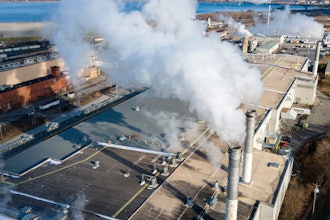Industrial Distribution had the chance to talk with Barry Misthal, Global Manufacturing Leader at PwC, concerning their quarterly publication “Assembling value: Industrial Manufacturing merger & acquisition activity.” The report highlights the types and frequencies of Mergers & Acquisitions made over the last quarter of 2011. Here is a brief summary of that lengthy report, with a Q&A with Barry Misthal to follow:
Industrial Manufacturing and Metals Deals Drive 2011 Industrial Products M&A Activity
NEW YORK, February 2, 2012 – The global industrial products (IP) industry experienced an increase in deal volume over the course of 2011 - 801 deals worth more than $50 million compared to 783 deals in 2010 – with industrial manufacturing and metals markets leading merger and acquisition (M&A) activity, according to a series of quarterly M&A reports released today by PwC US. The majority of deals within the IP sector were driven by companies focusing on smaller deals, an increase in divestitures and an uptick in local deals to create synergies. In addition, while strategic investors dominated overall activity, financial investors increased their participation in 2011 compared to the prior year.
PwC’s IP practice examined activity in the fourth quarter of 2011 and full year 2011 across six sectors: aerospace & defense (A&D), chemicals, engineering & construction, industrial manufacturing, metals and transportation & logistics.
The industrial manufacturing sector saw the largest increase in activity with deals worth more than $50 million totaling 161 deals in 2011 compared to 135 deals in 2010. The metals industry also increased in activity with 122 transactions worth more than $50 million in 2011 compared to 106 deals in 2010. Although total industrial products deal volume increased, total deal value for transactions worth more than $50 million decreased to $362.5 billion in 2011 from $462.6 billion in 2010. Mega deals or transactions worth more than $1 billion slightly decreased in 2011 with a total of 72, compared to 80 mega deals in 2010. This contributed to a lower average deal value for deals worth more than $50 million – $45 million in 2011 compared to $59 million in 2010.
“2011 was all about smaller deals in industrial products as dealmakers remained conservative focusing on deals that were seen as less risky and that needed smaller levels of capital in today’s uncertain economy. This trend was exemplified across the sector and especially in A&D where it was a record year for volume, mostly driven by smaller transactions, though we also note that a record deal in terms of size was announced in this sector,” said Bob McCutcheon, U.S. industrial products and metals industry leader at PwC. “Deal activity in 2012 will depend on more stabilized financial markets, a global recovery and abatement in concerns over the European debt crisis. An uptick in action across industrial products in 2012 is anticipated, and our latest Manufacturing Barometer reports that U.S. industrial manufacturers are expected to continue to increase investment spending in the year ahead, including operational spending, and plans for M&A with a significant emphasis on expanding into new markets” . . .
. . . “Faced with substantial uncertainty, companies appeared to be opting for growth within their familiar domestic markets. Such moves limit the legal and cultural risks typically associated with cross-border transactions. We’re also seeing higher growth prospects within emerging markets, which will likely keep Asian acquirers focused on targets within their borders. Mature markets such as the U.S. and Europe also continue to seek domestic consolidation as a tool for growth and competitor elimination,” added PwC’s McCutcheon. “One example of an exception was in the A&D space where European dealmakers increased activity, driven by both local market deals as well as outbound transactions. The increase in European outbound deals also contributed significantly to the overall rise in cross-border deals and foreign acquisitions of U.S. targets in 2011, totaling 20 local market transactions that were worth more than $50 million compared to 40 cross-border deals.”
“Strategic investors sought inorganic growth through acquisitions to stay current with global macro trends such as increasing global infrastructure,” added McCutcheon. “While financial investments did increase in 2011, this was mostly pertained to smaller deals. In 2012, financial investors are expected to continue their steady climb into deals in the space, but strategic investors will remain well positioned, given healthy liquidity levels, to drive a high volume of deals.”
A breakdown of PwC’s analysis of M&A activity and outlook for IP follows:
Industrial Manufacturing – After a strong start at the beginning of 2011, deal activity in the second half of the year softened with a shift away from larger, more transformative and impactful transactions. There was one mega deal in the fourth quarter of 2011 where both companies operated within the same semiconductor machinery manufacturing/chip equipment segment, indicating another trend in the market: a company’s desire to pursue acquisitions to establish a technological edge over its peers. The U.S. maintained its position as one of the most active countries in activity, followed closely by China and Japan, and interestingly, new emerging markets such as Mexico, surfaced as players in the deal arena in the fourth quarter of 2011. Global industrial manufacturing deals in the first half of 2012 are expected to remain fairly even with 2011 activity, but if the Euro crisis is resolved, companies hungry for growth along with strong fundamentals and cash-rich balance sheets could spur an increase in activity in the second half of 2012 and early 2013.
Metals – In 2011, there were 16 more deals that were worth more than $50 million than in 2010, but deal value declined to $55.2 billion from $92.6 billion. This 40 percent decline in value drove a decrease in average deal value as well, from $874 million to $452 million. Asia and Oceana drove overall deal value in 2011 with the majority of local deals also led by Asia and Oceania. This region is expected to continue to drive local deal activity in 2012 as China makes progress in consolidating its domestic metals industry. Given the current economic environment, the metals sector could see a moderate deal growth into 2012. However, the general collapse of aluminum prices impacting the bottom lines of large producers, accumulating stock levels and soft economic conditions further impacting pricing and the potential of a slowdown in the steel industry in 2012, given weakening global demand and the tighter control of the Chinese real estate market.
Transportation & Logistics – Overall deal volume and deal value stayed steady with 170 deals valued at $50 million or more in 2011 compared to 186 deals in 2010 but saw a drop in the fourth quarter of 2011 when compared to the previous quarter. The fourth quarter of 2011 produced three mega deals, which included a transaction valued at $4.2 billion that was also the largest for the full year. Emerging markets returned in the fourth quarter of 2011 with a majority of activity being driven by Europe and Asia as companies focus on consolidating to build economies of scale. Shipping and infrastructure deals are strategically positioned to lead the transportation & logistics industry in deal activity in 2012 as a result of shipping companies consolidating due to ongoing capacity issues and emerging markets investing in airport, ports, and roads.
The full report from PwC can be found online in PDF format at https://www.pwc.com/us/en/industries/industrial-products/library/industrial-manufacturing-deals-outlook.html.
Barry Misthal, Global Manufacturing Leader at PwC |
Industrial Distribution's Q&A with Barry Misthal
ID: Were these numbers what you had expected considering the current downturn in the economy? Are they pretty typical in a recession based environment?
I think as we mentioned in the report for the fourth quarter, the deal activity slowed significantly in the second half of 2011. It was a strong start to 2011 and I would say that if you looked at the first half of the year, you would have expected the second half coming in at much higher trending.
ID: You note in the report that deal trending is shifting away from larger, more transformative and impactful transactions. Is it an attempt to ensure success of those deals or to minimize client impact?
We see a steady trend in smaller deals, starting back in 2010 which continued in 2011. I think the lessening trend in mega deals is because of the uncertainty around global demand, so none of these companies really want to overpay given there is an uncertainty around a demand for their product. They are being much more cautious at the big deal level. At the smaller deal level, in the domestic markets in US or Asia, here you are seeing transactions continue because there is still growth within specific markets or within specific product categories, and those deals are normally smaller.
ID: Is this rise in Mergers & Acquisitions an indicator of a larger rebound or economic boost? Or is it not – is it evidence that the small businesses can’t make it right now and are getting eaten up by the larger corporations in the face of deteriorating profit margins?
I think it’s a combination of both things that you just mentioned. There is still a fair amount of competition at the small to mid-size company level and with uncertainty on demand those companies are merging or one is acquiring another. On the larger side, the trend for larger deals is just low because there is low demand. There is expected growth for 2012, and we have another publication, the PwC Manufacturing barometer, that discusses revenues and growth, but there is still not complete confidence in the underlying demand for product in the global economy. So you’ll have growth, but it’s not going to be at a rapid pace like before.
ID: What does this mean to the supply chain? What happens when suppliers at the top consolidate? Does it affect lead time on product? Or cost?
When suppliers consolidate you are looking for improved serviceability, in other words you are going to consolidate suppliers to help your lead time, or to get a better quality product out of your supplier. So competition amongst suppliers will be fierce. And that might help the smaller customer because that supply chain rationalization will continue with the heavy cost focus and cost production focus that will be continuing in 2012.
ID: You mention that transport & logistics sector is seeing an emerging rise in deal traffic – why? What does this mean for our readers, both the manufacturers who need materials to make products and our distributors who need products to distribute to clients? How will this trend affect them?
Connected to the lack of global demand what you have in the shipping and manufacturing sector is overcapacity. There will be a step-up in deals to reduce containers and try to consolidate transportation and logistics centers as far as possible, with the goal being cost reduction. There is a fair amount of excess capacity in shipping containers today, giving small companies a fair chance at a lower cost for distributing their product.
ID: In the report you mention that deals are focused on synergy more than globalization –what does that mean? Why are we seeing it?
Synergies are focused on cost efficiencies versus expanding into other markets like globalization. They give companies the opportunity to reduce cost or acquire capacity. On the other hand, globalization, where two companies get together to expand their market footprint or production footprint into different markets or different countries, is just too uncertain right now. Synergies are popular because there is always a need to look for partners who will help create cost savings and will enable you to grow your sales volume or create new volume.
ID: On page 15 of the report you discuss briefly technology – there is an enormous focus on “technological innovation, efficiency, and cost reduction,” for all sectors. What does this mean for the way the supply chain is going to operate in the future?
Electronic and equipment deals are going on because of a drive for cost reduction. It’s cheaper to buy technology sometimes than it is to get people or to set up to facilities or even expand facilities. I think the focus on driving technology innovation is on efficiency and cost reduction and that will help growth and prepare smaller companies to further expansion of their distribution network. It’s going to be a play between people and technology as far as cost efficiency is concerned.
ID: Over and over again the report stresses that companies are being conservative, spending less on mergers and spending less often. Any suggestions for a company looking to acquire –or be acquired – by anyone else at this point in the year?
If you are buying, you must have a good handle on what the forecast of demand is & the volume of sales of the company that you are going to recognize. You have to be cautious on what that company is worth because you don’t want to overpay. If you are going to be acquired, maximize the benefits of your product and your technology. That’s really what companies are after. Either you have a distribution network in a desirable market or you have products or technologies that are going to expand the breadth of the acquiring company so they fill in their product categories or their capacities.
ID: One last question: There is so much information out there, saying spending is up, it’s down, oil prices are skyrocketing and then dropping. It’s all, as a consumer, so hard to consume, hard to understand. If our clients in manufacturing and industrial distribution take away one thing from this report, what does it need to be?
That mergers and acquisitions will continue in 2012, although at a more conservative pace, and that M&A is still a very focused growth opportunity for strategic investors at this time.























